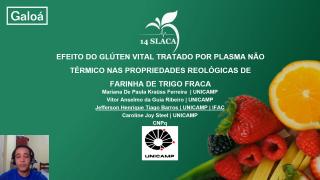Anais do Simpósio Latino Americano de Ciências de Alimentos
Actas del 14 SLACA - Simposio Latinoamericano de Ciencia de los Alimentos
EFFECT OF DIFFERENT TECHNIQUES ON THE EXTRACTION OF PHENOLIC COMPOUNDS FROM AGROINDUSTRIAL LIME (Citrus latifolia Tan.) RESIDUE
¿Cómo citar este artículo?
To cite this paper use one of the standards below:
¿Cómo citar este artículo?
- Tipo de presentación: Pôster
- Eje temático: Ingeniería de procesos y tecnologías emergentes
- Palabras clave: Extraction; Emerging technology;; phenolic compounds;
Autoras(es):
- 1 Universidade Estadual de Campinas
- 2 Faculdade de Engenharia de Alimentos / Universidade Estadual de Campinas
EFFECT OF DIFFERENT TECHNIQUES ON THE EXTRACTION OF PHENOLIC COMPOUNDS FROM AGROINDUSTRIAL LIME (Citrus latifolia Tan.) RESIDUE
Amanda Mellissa B Oliveira
Universidade Estadual de Campinas
Ahora podrías compartir conmigo tus preguntas, observaciones y felicitaciones.
Crea un tema- Tipo de presentación: Pôster
- Eje temático: Ingeniería de procesos y tecnologías emergentes
- Palabras clave: Extraction; Emerging technology;; phenolic compounds;
Autoras(es):
- 1 Universidade Estadual de Campinas
- 2 Faculdade de Engenharia de Alimentos / Universidade Estadual de Campinas
Lime (Citrus latifolia Tan.) is a citrus fruit marketed worldwide. Its processing generates a large amount of waste, of which approximately 50% is represented by bagasse (endocarp and mesocarp). The extraction of bioactive compounds from waste is a strategy to recover and add value to the agro-industrial by-products. Pressurized Liquid Extraction (PLE) and Ultrasound Assisted Extraction (UAE) are emerging techniques for obtaining bioactive compounds from plant matrices. Thus, the objective of this work was to compare different extraction techniques to obtain phenolic compounds from agro-industrial lime by-product. The extraction solvent was a mixture of ethanol and water (3:1, m/m), except for Soxhlet, which used pure ethanol. PLE was carried out at 10 MPa, 60, 85, and 110 °C, for 40 minutes. In UAE, powers of 160, 480, and 792 W were used, ranging time between 2 and 10 minutes at 20 kHz. Agitation extraction (300 rpm) used the same times as UAE and temperature of 72 °C. Soxhlet extraction was carried out for 6 hours. The total phenolic content (TPC) of the extracts was determined by the Folin-Ciocalteu method. The obtained TPCs were, in mg GAE/g sample: PLE (17.65 ± 0.03), UAE (9.95 ± 0.08), Agitation (3.65 ± 0.01), and Soxhlet (2.19 ± 0.05). The highest yield in PLE (110 °C) showed that temperature significantly influenced the extraction, whereas, in UAE, cavitation increased mass transfer and, therefore, the extraction of the target compounds. In general, the TPC of extracts obtained by emerging methods was higher than those obtained by conventional methods, demonstrating the great potential of these techniques to recover bioactive compounds from plant matrices.
Wow
Rafael Fernandes Almeida
Parabéns!!
- 1 like
- 1 respuesta
Excelente trabalho
Rayanne Priscilla França de Melo
Adorei seu trabalho, Amanda! Meus parabéns!
- 1 like
- 1 respuesta
Amanda Mellissa B Oliveira
Muito obrigada pelo elogio! :)
Excelente apresentação e ótimo resumo
Manoel Adenísio
Está de parabéns!! Continue desenvolvendo pesquisa!
- 1 like
- 1 respuesta
Amanda Mellissa B Oliveira
Muito obrigada pelo seu elogio, Manoel!
Adorei
Enylson Xavier Ramalho
Ótimo trabalho e muito bem apresentado, parabéns!
- 1 like
- 1 respuesta
Amanda Mellissa B Oliveira
Muito obrigada! :)
Appreciatable work
Dhanus Raj Kanaga Raj
Congratulations on your work! Worth watching. And the summary is neatly elobrated with a interesting title! Looking forward for your upcoming works!
- 1 respuesta
Amanda Mellissa B Oliveira
Hello, Dhanus. Thank you so much for your comment!
Elogio
Crislei Gonçalves Pereira
Parabéns pela apresentação, Amanda!
- 1 respuesta
Amanda Mellissa B Oliveira
Olá, Crislei. Tudo bem?
Muito obrigada pelo comentário. :)
Ótimo trabalho
Ingrid Moraes
Parabéns pelo trabalho Amanda! Adorei seu trabalho!👏🏻👏🏻
- 1 respuesta
Amanda Mellissa B Oliveira
Oi, Ingrid, muito obrigada pelo seu comentário! :)
Excelente!
Luciedry Matheus Souza Carvalho
Ótimo trabalho, parabéns!
- 1 respuesta
Amanda Mellissa B Oliveira
Oi, Luciedry! Muito obrigada pelo seu comentário! :)
Parabéns
Francielle Miranda de Matos
Tente superar essa minha amiga, e falhe haha
- 3 respuestas
Amanda Mellissa B Oliveira
Fraaaaaann!! Que saudade de você, menina! Tava falando isso pro Enylson ontem. hahaa
Amanda Mellissa B Oliveira
Ok, eu admito, talvez eu seja um pouco competitiva. kkkkkkkkk
Francielle Miranda de Matos
Hahaha vc trabalha enquanto eles dormem! Saudades!!!
Parabéns.
Celma Oliveira Barbosa
Amanda, obrigada pelo feedback em meu estudo. Aproveito para te parabenizar por seu estudo e brilhante apresentação de seus achados. Sua pesquisa é interessantíssima e de grande relevância para quem trabalha nessa área, pois precisamos de estudos que comparem as técnicas de extração para otimização de resultados. Sucesso!!! E, continue sua pesquisa.
- 1 respuesta
Amanda Mellissa B Oliveira
Oi, Celma. Tudo bem? Muito obrigada pelo seu comentário! Essa linha de pesquisa tem muito potencial para avançar ainda mais. No doutorado irei testar novas matérias-primas e condições. Abraços!
Optimice su evento académico
Con casi 200.000 artículos publicados, Galoá permite a los académicos compartir y descubrir investigaciones de vanguardia a través de nuestra plataforma de publicación académica optimizada y accesible.
Obtenga más información sobre nuestros productos:
¿Cómo citar este proceedings?
This proceedings is identified by a DOI , for use in citations or bibliographic references. Atención: este no es un DOI para el trabajo y, como tal, no se puede usar en Lattes para identificar un trabajo en particular.
Check the link "How to cite" en la página del papel, para ver cómo citar correctamente el papel



Amanda Mellissa B Oliveira
Muito obrigada! :)